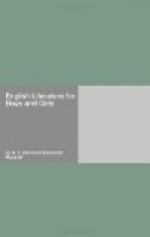Perhaps Langland’s friends saw that he was clever, and hoped that he might become one of the great ones in the Church. In those days (the Middle Ages they were called) there was no sharp line dividing the priests from the people. The one shaded off into the other, as it were. There were many who wore long gowns and shaved their heads, who yet were not priests. They were called clerks, and for a sum of money, often very small, they helped to sing masses for the souls of the dead, and performed other offices in connection with the services of the Church. They were bound by no vows and were allowed to marry, but of course could never hope to be powerful. Such was Langland; he married and always remained a poor “clerk.”
But if Langland did not rise high in the Church, he made himself famous in another way, for he wrote Piers the Ploughman. This is a great book. There is no other written during the fourteenth century, in which we see so clearly the life of the people of the time.
There are several versions of Piers, and it is thought by some that Langland himself wrote and re-wrote his poem, trying always to make it better. But others think that some one else wrote the later versions.
The poem is divided into parts. The first part is The Vision of Piers the Ploughman, the second is The Vision Concerning Do Well, Do Bet, Do Best.
In the beginning of Piers the Ploughman Langland tells us how
“In a summer season
when soft was the sun,
I wrapped myself in a cloak
as if I were a shepherd
In the habit of a hermit unholy
of works,
Abroad I wandered in this
world wonders to hear.
But on a May morning on Malvern
Hills
Me befell a wonder, a strange
thing. Methought,
I was weary of wandering,
and went me to rest
Under a broad bank by a burn
side.
And as I lay, and leaned,
and looked on the waters
I slumbered in a sleeping
it sounded so merry.”
If you will look back you will see that this poetry is very much more like Layamon’s than like the poetry of Havelok the Dane. Although people had, for many years, been writing rhyming verse, Langland has, you see, gone back to the old alliterative poetry. Perhaps it was that, living far away in the country, Langland had written his poem before he had heard of the new kind of rhyming verses, for news traveled slowly in those days.
Two hundred years later, when The Vision of Piers the Ploughman was first printed, the printer in his preface explained alliterative verse very well. “Langland wrote altogether in metre,” he says, “but not after the manner of our rimers that write nowadays (for his verses end not alike), but the nature of his metre is to have three words, at the least, in every verse which begin with some one letter. As for example the first two verses of the book run upon ‘s,’ as thus:
’In a somer season whan
sette was the sunne
I shope me into shrobbes as
I a shepe were.’




